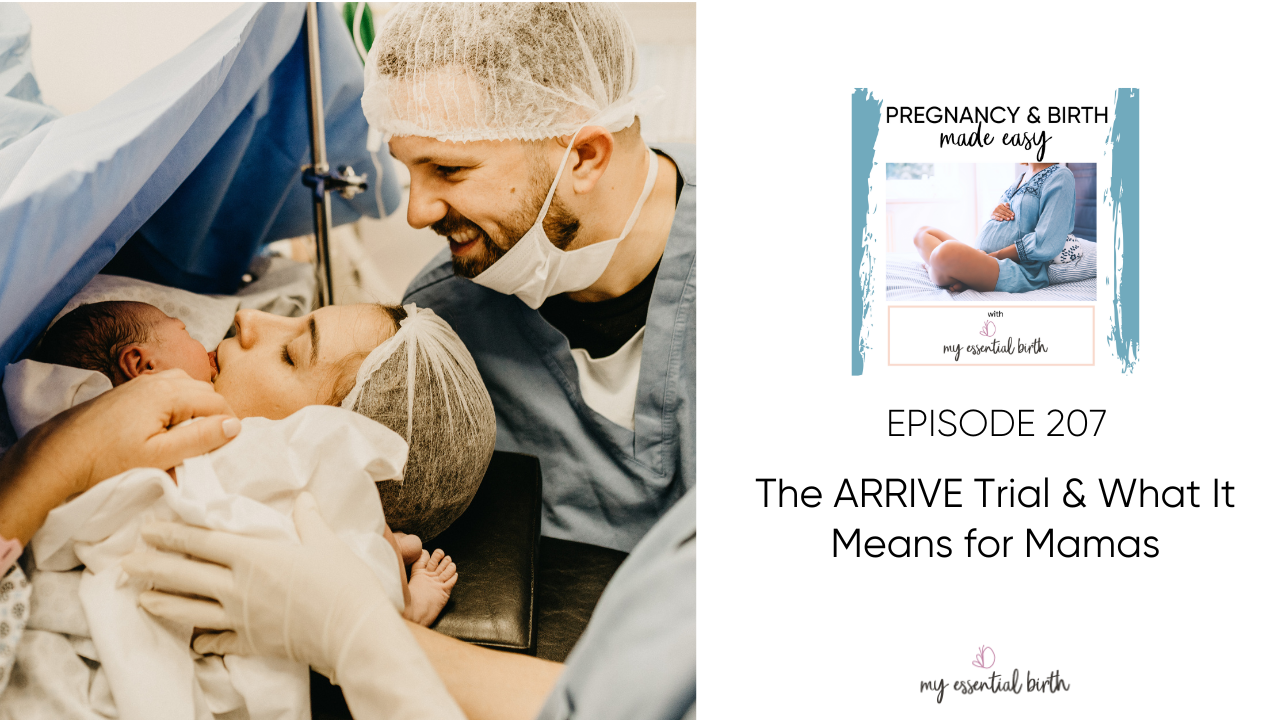
The ARRIVE Trial & What It Means for Mamas
Show Notes:
[2:15] Our Reviewer of the Week, kaihanks, says "Forever grateful to the friend who lead me to this podcast AND birth course! Between this podcast, the birth course, and all their resources, I feel educated, empowered, encouraged, and overall excited for this experience in my life!"
[3:05] This week's topic is the ARRIVE Trial. This ARRIVE (A Randomized Trial of Induction Versus Expectant Management) trial is the one that providers are leaning on and using as a reason to induce moms and to tell moms that because of this trial, they are finding that it's actually safer to induce at 39 weeks and that this is an evidence-based practice. During 2020 and this trial, inductions were pushed so much more than I had ever seen it done.
[6:45] The primary purpose behind the trial was that they wanted to figure out if the elective induction, during the 39th week of pregnancy, would result in a lower death and serious complication rate for babies compared to waiting till at least 40 weeks and five days for elective induction. The secondary purpose was to see if inductions led to more Cesareans.
[7:19] The participation spanned across 41 states, and researchers screened 50,581 moms. This had to be their first pregnancy with a baby that was head down, and it had to be for a low-risk, healthy mom. All moms had a bishop score of greater than five, which is gauge for if your body is favorable or not favorable for induction.
[9:42] The primary focus, which was the risk of serious complication for death for newborns, occurred in 4.3% of the babies in the induction group, and it occurred in 5.4% of babies in the expectant management group. The secondary focus was for cesarean rate. 18.6% of moms who were in the induction group ended up with a cesarean birth versus 22.2% for the moms that were in the expectant management group.
[10:38] The parameters for the study separated mothers into two groups, but do we know any of the following information to have a better birth outcome?
- Took a birth class
- Prepared and practiced things like relaxation practice, labor rehearsals, and meditation
- Understood how the body works and what's happening during the labor process
- Given tools to be able to utilize during labor
- Encouraged to walk around during labor, use water, have warm towels given to them, counter pressure
- Had a doula
- Felt good about their experience and how they were treated throughout the labor process
Even if you are a first time mom who is low risk, this study is not going to encompass all of that. If you have good information in your mind, then it gives you that opportunity when you're having conversations with your provider to be able to trust your intuition.
[14:25] What were the results? They found that moms in the induction group reported less pain on the 10 point scale, and they reported more perceived control during birth, meaning higher scores on the labor entry scale.
[16:21] Moms in the induction group spent more time in the labor and delivery unit, but the length of their postpartum hospital stay was actually shorter. The average birth weight was seven pounds, four ounces for moms who were induced versus seven pounds, seven ounces for moms who were part of that expectant management, which would be expected because we all know that first time moms have an average of 41 weeks and one day before they go into labor.
[16:59] What do the experts say? "We found that elective labor induction at 39 weeks of gestation did not result in a greater frequency of perinatal adverse outcomes than expectant management and resulted in fewer instances of cesarean delivery. These results suggest that policies aimed at the avoidance of elective labor induction among low risk nola paris women at 39 weeks of gestation are unlikely to reduce the rate of cesarean delivery on a population level."
[19:20] Should moms be offered induction at 39 weeks? I think when we start meddling with what our bodies are capable of doing, created to do, able to do on their own, we can experience some adverse outcomes, including how we feel about it, which is a really important part of birth that maybe is not being considered so much in the medical realm when they're offering those kinds of things. Keep in mind that with inductions do come interventions. However, I'm gonna remind you here that those were not necessarily women who were prepared for labor, knew the process, knew how to work through it, had support, all of that kind of stuff.
[21:51] Now what's interesting with this study is the Cesarean rates for the study involved were at 19%. Actual C-Section rates across the nation, at least here in the United States, is 33%.
[24:53] I hope this episode is gonna bring in some of that side information that is not being discussed when a provider offers something like this in the way of the parameters of the study, and it didn't take into account preparation of mom, what she knows about birth, how her support is, and how she set herself up with her provider.
To Leave a Review ⭐️
- Open Apple Podcasts
- Find “Pregnancy & Birth Made Easy” podcast
- Select “Ratings and Reviews”
- Click the stars!
- Select “Write a Review” and tell us what was the most amazing, comforting, eye-opening thing that you loved!
ALL the best,

Links Mentioned
Sources Mentioned



